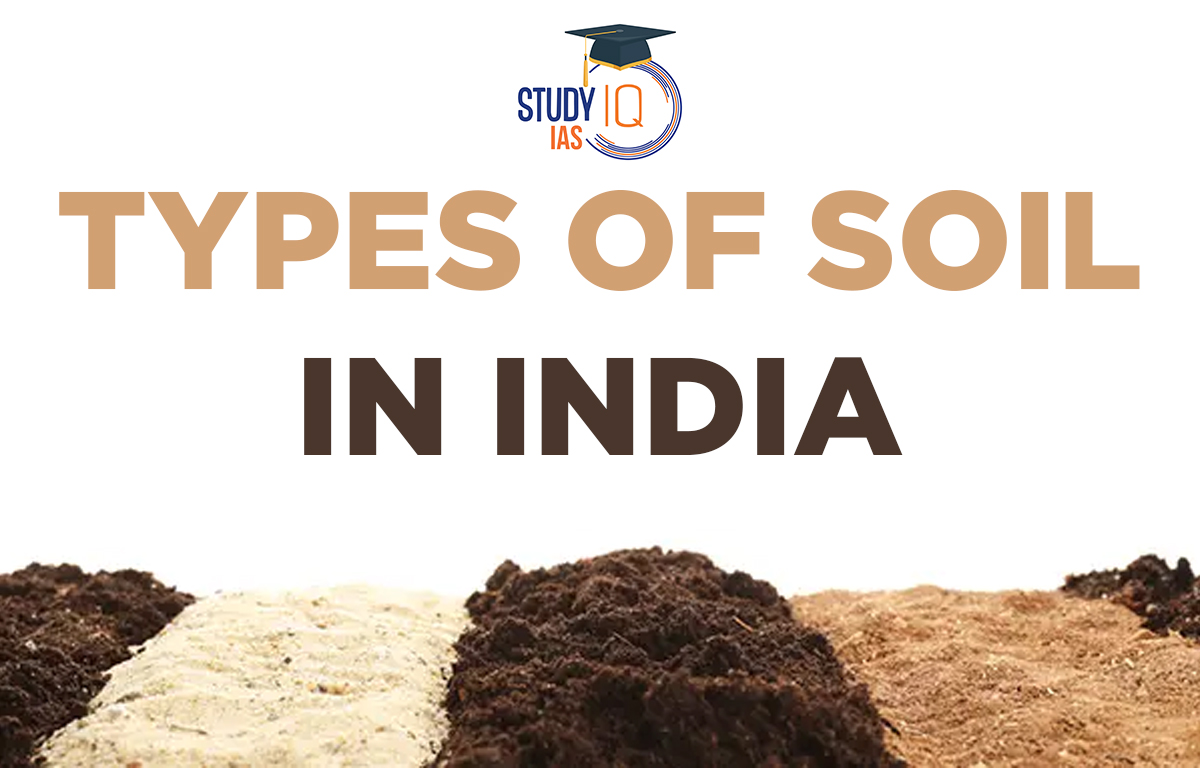Table of Contents
Types of Soil in India
The mixture of organic materials and rock fragments that forms on the surface of the ground is known as soil. Relief, parent material, climate, time, biodiversity, and human activities are the main elements influencing soil formation. India is a diversified nation, with a wide range of topographic characteristics, landforms, climatic zones, and flora kinds. These have helped to generate different Types of Soil in India. The majority of the components of soil include mineral/rock particles, fragments of decomposed organic materials, soil water, soil air, and living organisms. Parent material, relief, climate, vegetation, life forms, and time are the main variables that affect how soil is formed.
The four components of soil are air, water, organic matter (decayed and decomposed plants and animals), and inorganic or mineral portion derived from the parent material. The complicated process of soil creation known as “pedogenesis” occurs under specific natural conditions, and each component of the environment plays a part in this process.
The horizon is the term for each soil layer, each of which has a unique texture:
- Horizon A (Topsoil): It is the uppermost layer where organic components have combined with the minerals, nutrients, and water elements required for plant growth.
- Horizon B (Subsoil): Compared to other zones, this one contains a higher concentration of minerals and less humus. It is a transition between Horizon A and Horizon C and contains stuff that was derived both from below and above.
- Horizon C (weathered and decomposed rock): Loose parent/rock material makes up this zone. The two layers above are eventually formed from this layer, which is the first step in the development of soil.
Major Types of Soil in India
The Indian Council of Agricultural Research (ICAR) has categorized soils in India into eight types:
1. Alluvial Soil
Alluvial soil forms when rivers deposit sediments. Most rivers start in the Himalayas and carry a lot of sediment that settles on the riverbanks. This soil is made up of clay, sand, and silt. It is very fertile because it has the right amounts of potash, lime, and phosphoric acid.
| Alluvial Soil |
|
2. Black Soil
Black soil, also called “regur” (from the Telugu word “reguda”) is made from volcanic rocks and lava. Cotton is the main crop grown in this soil. It has enough potash, magnesium carbonate, and calcium carbonate to help cotton grow well.
| Black Soil |
|
3. Red & Yellow Soil
Red and yellow soil also called the “omnibus group,” covers about 18.5% of India’s land. It is found in areas with low rainfall like the eastern and southern parts of the Deccan Plateau.
| Red Soil |
|
4. Desert Soil
Desert soil also called arid soil, covers more than 4.42% of India’s land. It ranges in color from red to brown. This soil has a sandy to gravelly texture, low moisture, and does not hold water well. It is naturally salty, and in some places, the salt content is so high that common salt can be made by evaporating water.
| Desert Soil |
|
5. Laterite Soil
Laterite soil gets its name from the Latin word “later,” which means brick. It covers about 3.7% of India’s land and forms in areas with seasonal monsoon rains. The rain washes away lime and silica, leaving soil that is rich in iron oxide and aluminum. Laterite soil has a lot of iron oxide and potash but is low in organic matter, nitrogen, phosphate, and calcium. This means it is not very fertile on its own, but it can improve with the addition of manure and fertilizers.
| Laterite Soil |
|
6. Mountain Soil
Mountain soil is found in forested areas with enough rainfall. The texture of the soil depends on the mountainous terrain. On the valley sides, the soil is loamy and silty while on the upper slopes, it is coarse-grained. In the snow-covered regions of the Himalayas, the soil is acidic, bare, and has little humus. However, the soil in the lower valleys is very fertile.
| Mountaine Soil |
|
7. Alkaline Soils
This soil is very infertile and has high levels of sodium, potassium, and magnesium. Due to the dry climate and poor drainage, it contains a lot of salt.
| Saline or Alkaline soil |
|
8. Peaty and Marshy Soils
Peaty soil forms because of the high amount of organic material that builds up in humid climates. It has low levels of phosphorus and potash.
| Peaty and marshy soils |
|
Types of Soil in Indian Forest
|
Sr. No. |
Types of Forest Soils |
Characteristics |
| 1 | Brown Forest Soil |
|
| 2 | Podzol |
|
| 3 | Alpine Meadow soil |
|
Classification of Different Types of Soil in India: USDA Soil Taxonomy
|
Sr. No. |
Order of Soils in India |
Percentage |
| 1 | Inceptisols | 39.74 |
| 2 | Entisols | 28.08 |
| 3 | Alfisols | 13.55 |
| 4 | Vertisols | 8.52 |
| 5 | Aridisols | 4.28 |
| 6 | Ultisols | 2.51 |
| 7 | Mollisols | 0.40 |
| 8 | Other | 2.92 |
What is Soil Erosion?
Soil erosion is when the top layer of soil is removed. Basically, soil forms and erodes at the same rate, keeping a balance. But sometimes this balance is disturbed and soil erodes faster than it forms. This is called soil erosion. In dry areas, wind causes soil erosion, while in places with heavy rain, water is the main cause. There are two main types of water erosion: sheet erosion and gully erosion.
Sheet erosion happens on flat fields after heavy rain, washing away the topsoil.
Gully erosion occurs on steep slopes when runoff water creates deep channels or gullies. These gullies can grow deeper with more rain, cutting farmland into unusable pieces. Areas with many gullies are called “badland topography,” like the Chambal valley in Madhya Pradesh. You can also find them in West Bengal and Tamil Nadu.
Soil erosion causes rivers to carry eroded materials downstream reducing their water-carrying capacity and increasing the risk of floods and damage to farmland. Coastal soils are also damaged by tidal waters from the Arabian Sea and the Bay of Bengal, with severe erosion seen on beaches in Gujarat, West Bengal, Odisha, Kerala, and Tamil Nadu.
Deforestation is a major cause of soil erosion especially in hilly areas. Intensive farming that uses a lot of water and chemical fertilizers has led to waterlogging and salinity in many parts of the country, reducing soil fertility over time. This problem is common in areas that benefited from the Green Revolution, like the River Valley Projects. It’s estimated that about half of India’s land is degraded to some extent. Soil degradation causes India to lose millions of tonnes of soil and nutrients each year, harming the country’s productivity.
Soil Conservation & its Methods
Soil conservation is a way to keep soil healthy, stop it from being washed or blown away, and fix damaged soil. It includes farming methods and management techniques to reduce soil erosion.
Some methods to prevent soil erosion are:
- contour bunding,
- contour terracing,
- controlled grazing,
- regulated forestry,
- cover crops,
- mixed farming,
- and crop rotation.
Planting trees helps reduce soil erosion, and it is important to avoid cutting down trees unnecessarily. During the rainy season, floods can happen, so it is important to store or divert extra rainwater. One idea is the Ganga-Kaveri link Canal Project. Fixing gullies and ravines is also important to stop soil erosion. In the Chambal ravines in Madhya Pradesh, projects like plugging gully mouths, building bunds, leveling gullies, and planting cover plants are being done. Shifting farming (slash and burn) is a major cause of soil erosion in the Western and Eastern Ghats and northeast India. Farmers should be encouraged to switch to terraced farming. In the seven states of northeast India, a plan has been started to regulate shifting farming. This plan helps families who practice shifting cultivation (Jhumming) to switch to settled farming.


 Story of Meera Bai and Her Devotion For ...
Story of Meera Bai and Her Devotion For ...
 Desert Climate, Distribution, Climatic C...
Desert Climate, Distribution, Climatic C...
 Deserts of India Map, Features of Thar D...
Deserts of India Map, Features of Thar D...





















